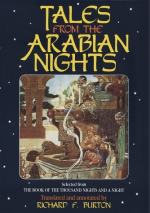The Tale of Attaf (Pp. 129-170).
P. 138, note 6.—I may add that an episode is inserted in the Europeanised version of this story, relative to the loves of the son of Chebib and the Princess of Herak, which is evidently copied from the first nocturnal meeting of Kamaralzaman and Budur (No. 21, Nights, iii., pp. 223-242), and is drawn on exactly similar lines (Weber, i. pp. 508-510).
History of Prince Habib, and
What Befel Him with the
Lady Durrat Al-Ghawwas (Pp. 171-201).
P. 197, note 1.—Epithets of colour, as applied to seas, frequently have a purely mythological application in Eastern tales. Thus, in the story of Zaher and Ali (cf. my “New Arabian Nights,” p. 13) we read, “You are now upon an island of the Black Sea, which encompasses all other seas, and flows within Mount Kaf. According to the reports of travellers, it is a ten years’ voyage before you arrive at the Blue Sea, and it takes full ten years to traverse this again to reach the Green Sea, after which there is another ten years’ voyage before you can reach the Greek Sea, which extends to inhabited countries and islands.”
Kenealy says (in a note to his poem on “Night”) that the Atlantic Ocean is called the Sea of Darkness, on account of the great irruption of water which occasioned its formation; but this is one of his positive statements relative to facts not generally known to the world, for which he considered it unnecessary to quote his authority.
P. 200.—According to one account of impalement which I have seen, the stake is driven through the flesh of the back beneath the skin.
Reading the account of the Crucifixion between the lines, I have come to the conclusion that the sudden death of Christ was due to his drinking from the sponge which had just been offered to him. The liquid, however, is said to have been vinegar, and not water; but this might have had the same effect, or water may have been substituted, perhaps with the connivance of Pilate. In the latter case vinegar may only have been mentioned as a blind, to deceive the fanatical Jews. The fragmentary accounts of the Crucifixion which have come down to us admit of many possible interpretations of details.
Index to the Tales, and Proper Names, Together with Alphabetical Table of Notes in Volumes XI. To XVI.
Also
Additional Notes on the Bibliography
of the Thousand
and One Nights.
Index to the Tales and Proper Names in the Supplemental Nights.
N.B.—The Roman numerals denote the volume,
the Arabic the page.
{The Arabic numerals have been discarded}
Abbaside, Ja’afar bin Yahya and Abd Al-Malik
bin Salih the, i.
Abd Al-Malik bin Salih the Abbaside, Ja’afar
bin Yahya and, i.
Abdullah bin Nafi’, Tale of Harun Al-Rashid
and, ii.
Abu Niyattayn, History of Abu Niyyah and, iv.
Abu Niyyah and Abu Niyyatayn, History of, iv.




